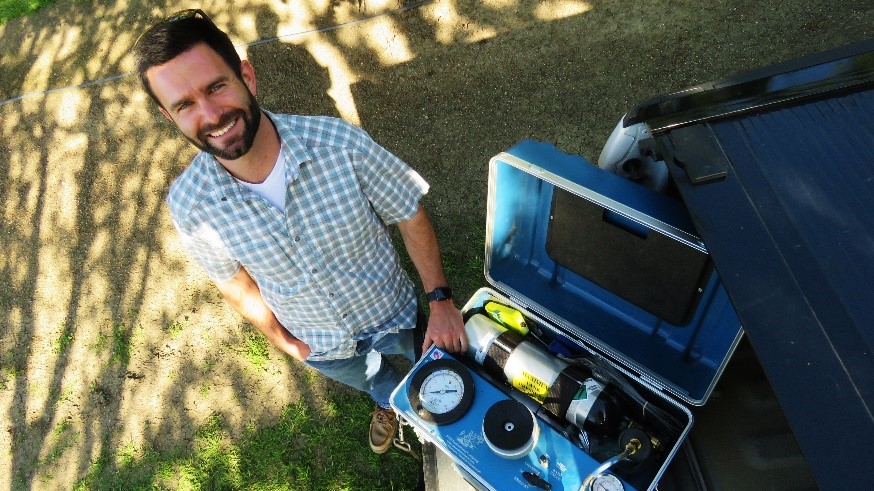In the last edition of the California Almond Outlook, the Almond Board of California (ABC) featured Part I of its interview with Will Martin, irrigation supervisor at Capay Farms based in Orland, California. In it, Martin shared why the pressure chamber is his tool of choice for scheduling irrigations and reducing tree stress. You can read Part I here in case you missed it.
In Part II of ABC’s conversation with Martin, he shares advice for growers who are new to using a pressure chamber, orchard benefits he has seen by implementing Almond Irrigation Improvement Continuum practices, and tips for growers on how to use the Continuum as a resource. For Martin, it’s about mastering the fundamentals of irrigation and focusing on the areas that will provide the best returns in the orchard.
 Will Martin, irrigation supervisor at Capay Farms in Orland, California, uses pressure chamber readings to ensure his water applications irrigate trees efficiently and effectively.
Will Martin, irrigation supervisor at Capay Farms in Orland, California, uses pressure chamber readings to ensure his water applications irrigate trees efficiently and effectively.
What advice would you give to a grower just starting out with a pressure chamber?
Don’t measure everywhere. Measure in one spot for a while and learn how to take the measurements accurately. The next critical step is to gather the information in an easy-to-use format. I use an app on my phone that compliments my brand of pressure chamber. It makes data collection easy and immediately shows me the results so I can adjust our schedules for optimal irrigation. I would tell a grower that if you’re going to use a pressure chamber, you have to use the app with it. Otherwise, you’ll have too much information and you won’t know what to do with it.
Now that you’ve been using the pressure chamber in combination with the app for a few years, what results have you seen?
The biggest benefit has been exposing differences and variability in the soil. I use the pressure chamber twice a week — before and after an irrigation — at one spot for every 50 acres. Last year, we ran the same schedule 10–12 hours a night on a couple of blocks. Because of soil variability and plant water availability, we ran half as much water on one block compared to the other. When you start to use the pressure chamber, you recognize how much water is applied in an hour. If you adjust an hour here or an hour there, you might save two irrigations in a season. That’s real savings. Ultimately, we’re talking about better growing conditions for the tree; reducing oversaturation and dry conditions.
What advice do you have on other measurement areas of the Continuum?
Automated soil moisture sensors, which qualify as a Level 3.0 practice, are a good tool. We use them and they store data over time. They tell you how deep water is going and how much is being held in the soil. Even with this great technology, we also still use the Level 1.0 practice, which is evaluating soil moisture based on feel and appearance using an auger.
How would you describe returns on investment (ROI) associated with reaching Level 3.0?
I can’t put a specific number on the ROI, but the benefit is creating a much healthier growing condition for the tree. We’re in year three of implementing the pressure chamber and using the results. I have the most faith in the pressure chamber compared to almost all other irrigation management tools, and we’re in year two or three of better understanding water holding capacity.
Thank you for your time and for sharing your irrigation experiences.
My pleasure.
____________________________________________________________________________
Not sure where to start or how your current practices compare to Continuum management levels?
Log in to your California Almond Sustainability Program (CASP) account at www.SustainableAlmondGrowing.org and complete the short Continuum assessment.
Don’t have a CASP profile? Sign-up is free and easy, providing access to helpful tools, such as nitrogen and irrigation calculators, and information about in-orchard best management practices.
Growers interested in learning more about the Almond Irrigation Improvement Continuum can also contact ABC’s Spencer Cooper, senior manager of irrigation and water efficiency, at scooper@almondboard.com or (209) 604-3727. Cooper’s one-on-one in-orchard consultation is free of charge and available to any California Almond grower. For more information, visit the Almond Board of California’s website at www.Almonds.com/Irrigation.